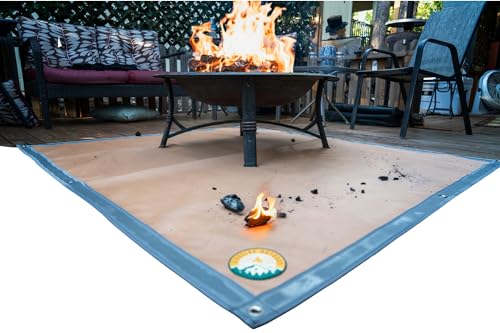If you’re yearning for the comfort and warmth of a fire pit but only have a deck to work with, you might be pondering the safety and practicality of such an arrangement. The quick answer is yes, you can put a fire pit on a deck. However, you’ll have to navigate through local codes, insurance implications, and safety concerns to make it a feasible option. Let’s delve into the nitty-gritty.
Table of Contents
Understanding Local Regulations
Before going full steam ahead with your fire pit project, it’s crucial to familiarize yourself with local city or county codes. Many jurisdictions prohibit the use of open flames on wood decks or within a certain distance from your home. If you get a green light from local authorities, they will likely outline rules for safely installing and operating fire pits on decks.
Pro Tip: Always consult your home insurance provider about how a deck fire pit might affect your policy. You may have to notify them, especially if you live in an area prone to wildfires.
Choosing the Right Fire Pit for Your Deck
Assuming you’ve cleared the legal hurdles, the next step is picking the ideal fire pit for your deck. Gas-powered fire pits are generally the safest option as they pose minimal fire risks. A well-placed gas fire pit won’t generate sparks that could ignite nearby surfaces. So, opt for one that complements your deck’s decor.
When it comes to wood-burning fire pits, stick to seasoned hardwoods like black locust, oak, or hickory to minimize sparking. Softwoods like pine or spruce are a no-go. If you opt for a wood-burning fire pit, make sure it’s installed on a non-combustible base. Otherwise, you run the risk of sparks and embers falling onto the deck, which could lead to a fire.
Safety Concerns to Consider
Installing a fire pit on your deck is not without risks:
- Fire Hazards: Sparks can easily land on dry leaves or other flammable materials, potentially igniting a fire.
- Structural Integrity: Before starting, consult a local contractor or structural engineer to ensure your deck can safely accommodate the weight of a fire pit, especially a custom-made one.
How Hot Do Fire Pits Get?

A wood-burning fire pit can reach temperatures as high as 1,200 degrees Fahrenheit. Keep this in mind when planning, as it affects your choice of deck material and fire pit design.
Preparing Your Deck for a Fire Pit
When installing a fire pit, especially a wood-burning one, create a no-burn zone around it. Place it away from flammable objects and consider flame-resistant surfaces underneath to catch any rogue sparks.
Accessibility and Comfort
Plan for adequate space for seating and ensure that people can move around comfortably. Consider lighting a pathway to the fire pit if it’s separate from your main dining area.
The Wind Factor
Always consider the prevailing winds. Nobody wants a face full of smoke, so conduct a wind check before finalizing your fire pit’s location.
Different Deck Materials and Their Fire Pit Compatibility
- Wood Decks: Risk of fire damage and weakening of the structure.
- Composite Decks: Durable but prone to warping and melting under extreme heat.
- Vinyl Decks: Highly combustible and sensitive to temperature changes.
- Concrete Decks: Non-combustible and ideal for fire pits.
Fire Pit Safety Gear and Accessories

Even with the best precautions, accidents can happen. Always have a water source, fire extinguisher, and hose nearby for emergencies.
Barrier Options for Deck Fire Pits
- DIY Fire Pit Pad: A grid of pavers under the fire pit’s base.
- Heat-Resistant Mat: Comes in various sizes and is made from fire-resistant materials.
- Metal Fire Pit Screen: Safest but comes with limited size options.
- Insulated Barriers: Vented metal trays elevated by rubber feet.
Weight Considerations
Before making a purchase, always ensure your deck can handle the weight of the fire pit, especially if it requires a stone base.
Final Thoughts
Installing a fire pit on your deck can be both a cozy and aesthetically pleasing addition to your home, provided you do your homework. Always follow local codes, ensure structural integrity, and prioritize safety for an enjoyable and stress-free experience.
Last update on 2024-04-27 / Affiliate links / Images from Amazon Product Advertising API
This post contains affiliate links, which means I may receive a small commission, at no extra cost to you, if you make a purchase using these links.





